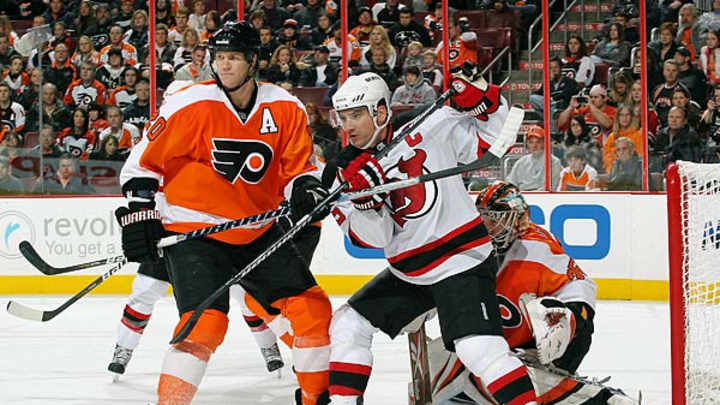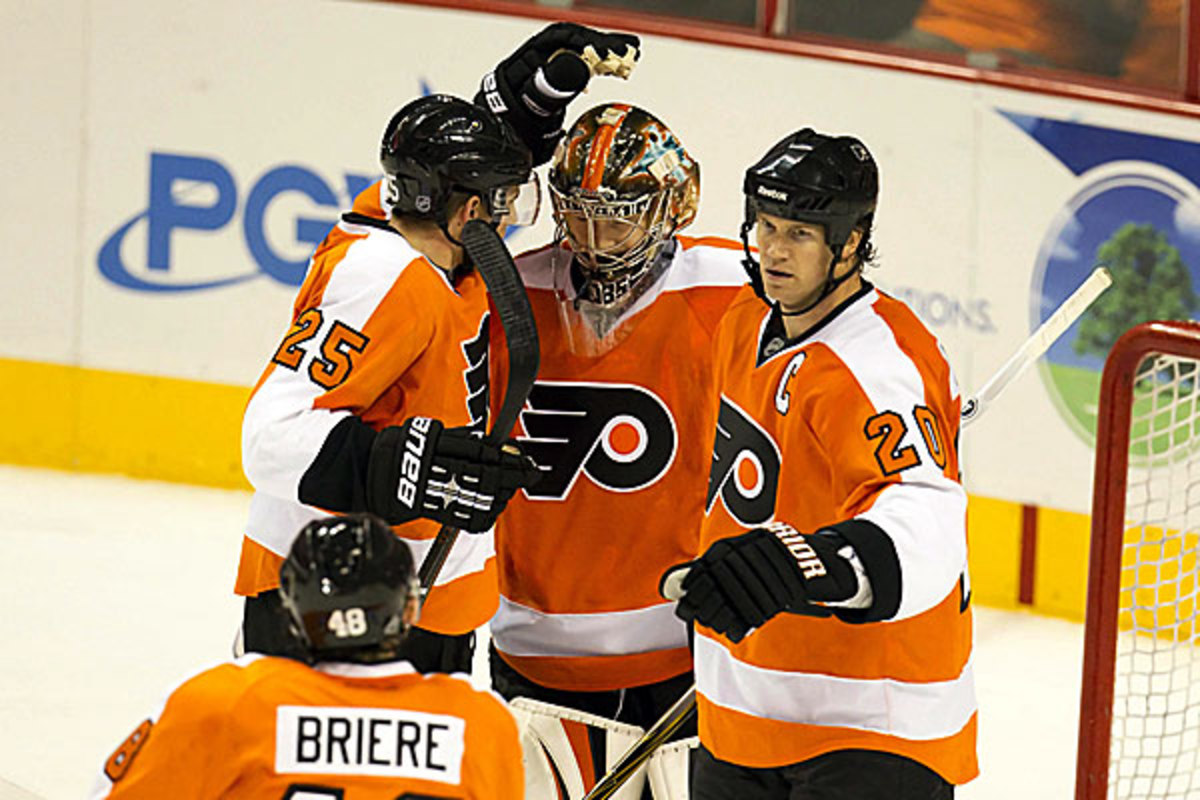Can NHL do more about concussions?

The Flyers are showing signs that they'll remain competitive after the loss of captain Chris Pronger, but the NHL still has work to do in preventing harmful head contact. (Christopher Szagola-US PRESSWIRE)

By Stu Hackel
When the Flyers traded for Chris Pronger during the 2009 draft, GM Paul Holmgren said, "I made it sort of clear I would like to get a hammer, a guy who makes life miserable for the other team. This is one of those guys."
Today, that hammer is broken, perhaps for good.
Pronger, the Flyers' captain, has been declared out for the rest of the season and there are legitimate questions as to whether his career is over. The consequences of this news will play out over time and are multifaceted. His absence will not only impact the Flyers, but the entire NHL as well as the state of the game as it contends with the ongoing problem of concussions.
When we talk about Chris Pronger, we're not talking about an average or even above-average hockey player, but a truly dominant one. Supremely well-conditioned even at age 37, and perhaps not as mobile as he once was, Pronger was still mobile, strong, smart and mean enough to be the highly effective anchor of a potential Stanley Cup contender.
If experience matters more for an NHL defenseman than for players at any other position -- and it does -- Pronger had a ton of it. Few in the history of the game have ever played at as high a level. Remember, he is one of only two players to win both the Norris Trophy as top defenseman and the Hart Trophy as league MVP in the same season. The other was Bobby Orr.
Like Sidney Crosby, who is also sidelined with his own concussion-related issues, Pronger has both ardent supporters and harsh detractors. Crosby's biggest crime in his critics' view seems to be that he whines too much. No one would accuse Pronger of that. His critics have other complaints.
There are some, no doubt, who probably rejoice at the news that Pronger is suffering and his career is in jeopardy. It's the old sword story: You live by it, you die by it. And if Schadenfreude is your thing, this is a happy day for you.
But like Crosby, like all those NHLers past and present who are concussion victims, Pronger's suffering is not good for the sport.
The most dismaying part of this is that in the current spike in NHL concussions, including Crosby's and a number of other high-profile players, Pronger's was the most preventable. Had he merely been wearing a face shield on his helmet on Oct. 24 when the stick of Toronto's Mikhail Grabovski caught him in the right eyelid, it's quite possible that he'd be in the lineup on Saturday afternoon playing against the defending Stanley Cup champion Bruins.
At the time, Pronger wasn't thought to have suffered a concussion. He was considered totally recovered from the stick to the eye that had kept him out of the lineup for two weeks. He returned on Nov. 9 and played five more games. But in the fourth game, on Nov. 17 against Phoenix, he went face-first into the glass after being hit by Martin Hanzal and fell to the ice, something the big, strong Pronger rarely if ever does.
[vodpod id=Video.15827658&w=425&h=350&fv=hlg%3D20112012%2C2%2C262%26amp%3Bevent%3DPHI709%26amp%3Bserver%3Dhttp%3A%2F%2Fvideo.nhl.com%2Fvideocenter%2F%26amp%3Bpageurl%3Dhttp%3A%2F%2Fvideo.nhl.com%2Fvideocenter%2F%26amp%3Bnlwa%3Dhttp%3A%2F%2Fapp2.neulion.com%2Fvideocenter%2Fnhl%2F]
It hardly seems like a devastating hit, but it was from behind and it thrust Pronger's head into the glass. There was no call. However, it may have been enough to trigger his concussion symptoms, which were first thought to be a virus.
"For a player skating with a relatively fresh head injury, it might not take the biggest hit in the world to wreak havoc," wrote Frank Seravalli on The Philadelphia Daily News' hockey blog. "Sometimes, the second hit is the one that does the most damage."
The next day, Pronger admitted to not feeling right. He played one more game, then left the lineup. Since then, the Flyers have gone 8-3-0 and it's probably the first time they've been able to win consistently without him. When he was out with his eye injury, they went 4-3-1. They are also missing their best forward now -- Claude Giroux, who was leading the league in scoring when he went down with a concussion earlier this week.
Last season, when Pronger missed long stretches with a damaged hand, the Flyers fared less well, especially in the playoffs where they were swept in the second round by Boston, a team they had defeated in seven games the year before after coming back from an 0-3 deficit on their way to the Stanley Cup Final against Chicago.
But unlike last season's Flyers, this edition seems more resilient after being transformed during the offseason to be bigger and grittier by adding more players in Pronger's mold. They also added yet another aging scoring star, Jaromir Jagr, who has surprised the league with his fine play and been a leader for this group. These changes have may have made the Flyers less vulnerable to Pronger's loss.
It's quite possible that Holmgren -- who will have salary cap space from Pronger going on the long-term Injured Reserve list -- could make a move for another defenseman, but there seems to be no need at the moment. As long as the Flyers continue to play well, Holmgren can afford to be a patient shopper. As teams begin to drop out of the playoff hunt and move players in preparation for their offseason makeovers, the list of available substitutes will lengthen.
Pronger's eye injury sparked a renewed discussion on whether the NHL should make visors mandatory. That debate has now moved off the front burner, replaced more recently by fighting and concussions. Hockey never seems to be rid of controversy for very long and it is often the same subjects.
No Simple Solutions
As we noted on Wednesday, the initial decline in concussions at the start of the season has been supplanted by a spike that finds there's little change from last season, despite some very good efforts by the NHL strengthen the rules, lengthen the suspensions and "soften" the playing environment. This might be a temporary leap, but it might not.
Many are wondering what the NHL should do, apart from what it is already doing, to combat the ongoing problem of traumatic head injuries. There are many suggestions.
Bob McKenzie noted Friday morning on TSN Radio 990 in Montreal, "Everybody want to simplify it and everybody wants to make a lot of noise about it. There's two kinds of people in hockey now...those who think it's out of control, an epidemic, you know, the hysterical reaction to this wave of people having head injuries, or it's people who say, 'You know what? I'm sick and tired of the whole damn thing. They're taking hitting out of hockey, the game's becoming too soft, you guys are big boys. It's a dangerous game; too bad.' And those seem to be the two polar opposite camps.
"And I don't know that there's a lot of people in between, which makes it difficult because there's nothing ever as simple as we want to make it."
Yes, this is a rough game with inherent risks. Most fans like it that way, but to not seek change in the face of a real problem just isn't an acceptable response. The NHL knows that. It understands it cannot be negligent of its responsibility to provide a safe environment for its players, if only because there are potential legal implications (and The Globe and Mail on Friday discussed whether NHL players could successfully file lawsuits against the NHL for negligence due to concussions as NFL players have done). So they must act. How is the question.
There is concern that players are returning too quickly from their concussions. Unfortunately, the science of diagnosing and treating concussions isn't keeping pace with what is happening on the ice. The ImPACT tests that players take, while important and valuable indicators, are obviously not totally accurate. Both Pronger and Giroux passed them, only later to learn that they, indeed, had been concussed. And, as The New York Times reported this week when discussing the return of Crosby's symptoms, the tests lack the sensitivity to determine when someone is completely recovered from a concussion.
But science is going hard at it, trying to come up with answers.
Meanwhile, the NHL would be wise to go hard at it, too, and step up its efforts at concussion prevention where it can. Players accidentally colliding in open ice is one thing; that can't be helped. But players who deliberately target another's head is something else. They can't prevent the accidents, like Giroux's, but perhaps this latest spike tells us the NHL should consider that it needs to go a bit further, do a bit more to prevent the willful acts players commit that endanger other's heads.
Hockey Hall of Famer Ken Dryden urges the NHL rethink how it currently approaches the situation in a new article for the online magazine Grantland. Dryden writes, "No amount of well-modulated, reasonable- and responsible-sounding words change the fact that a hit to the head, whether by elbow, shoulder, or fist, is an attempt to injure that needs to result in expulsion or suspension."
What Hanzal did to Pronger was not considered a penalty or worthy of any suspension. Perhaps that should be rethought.
What David Krejci did by quickly bringing up his elbow or forearm to hit Crosby's head -- shown in the replays at the end of the video below -- wasn't considered a penalty or worthy of a suspension.
Perhaps that should rethought, too.
Right now, the fines and suspensions that the NHL doles out to players for hits that are less borderline than those are plainly not enough to prevent others from committing similar acts. Fines of $2,500 don't do it. Three- and four-game bans don't do it. An eight-game ban for a repeat offender doesn't do it. Perhaps they all need to be longer.
As aggressive as the NHL has been in the last couple of years, it still may not be aggressive enough.
